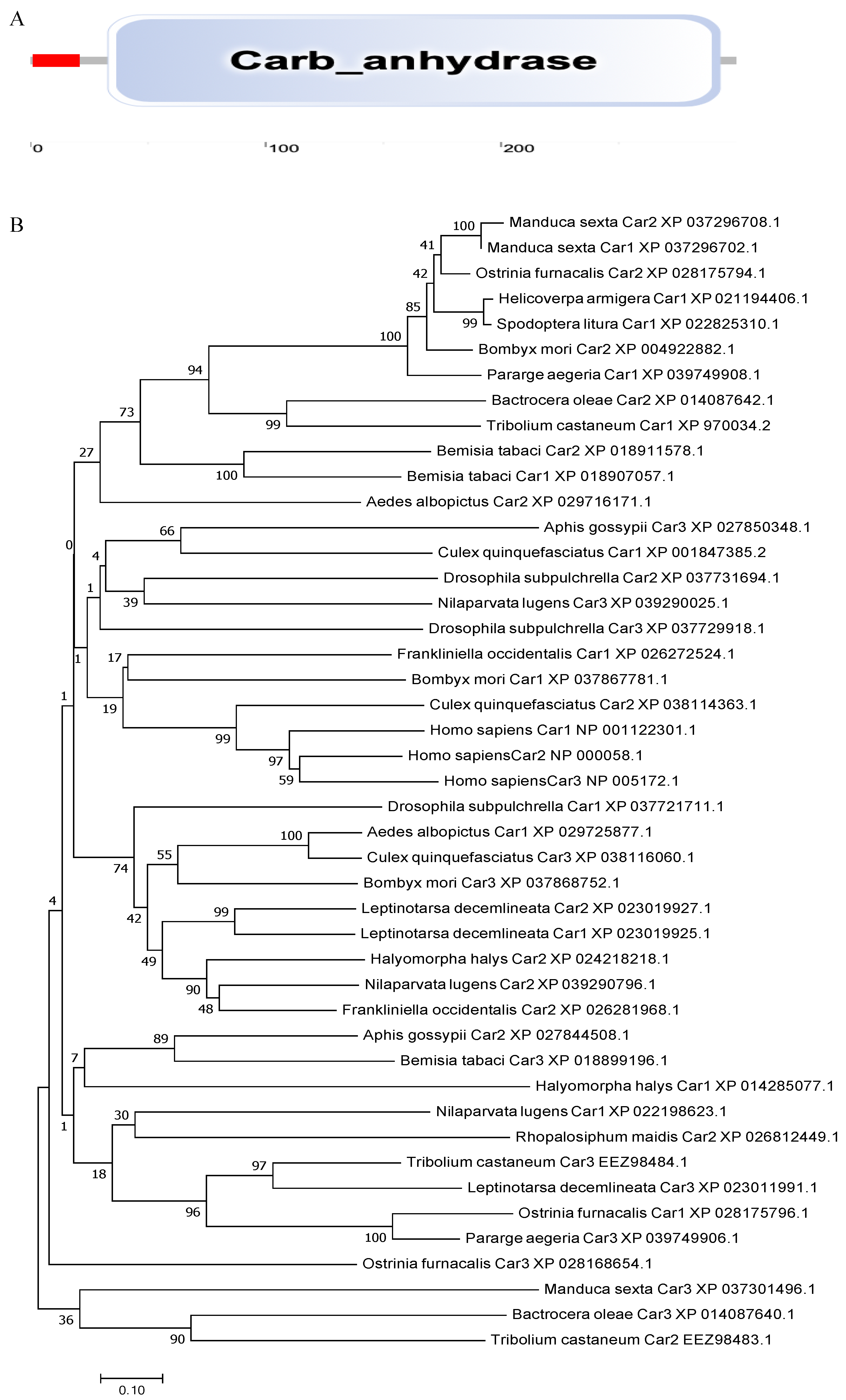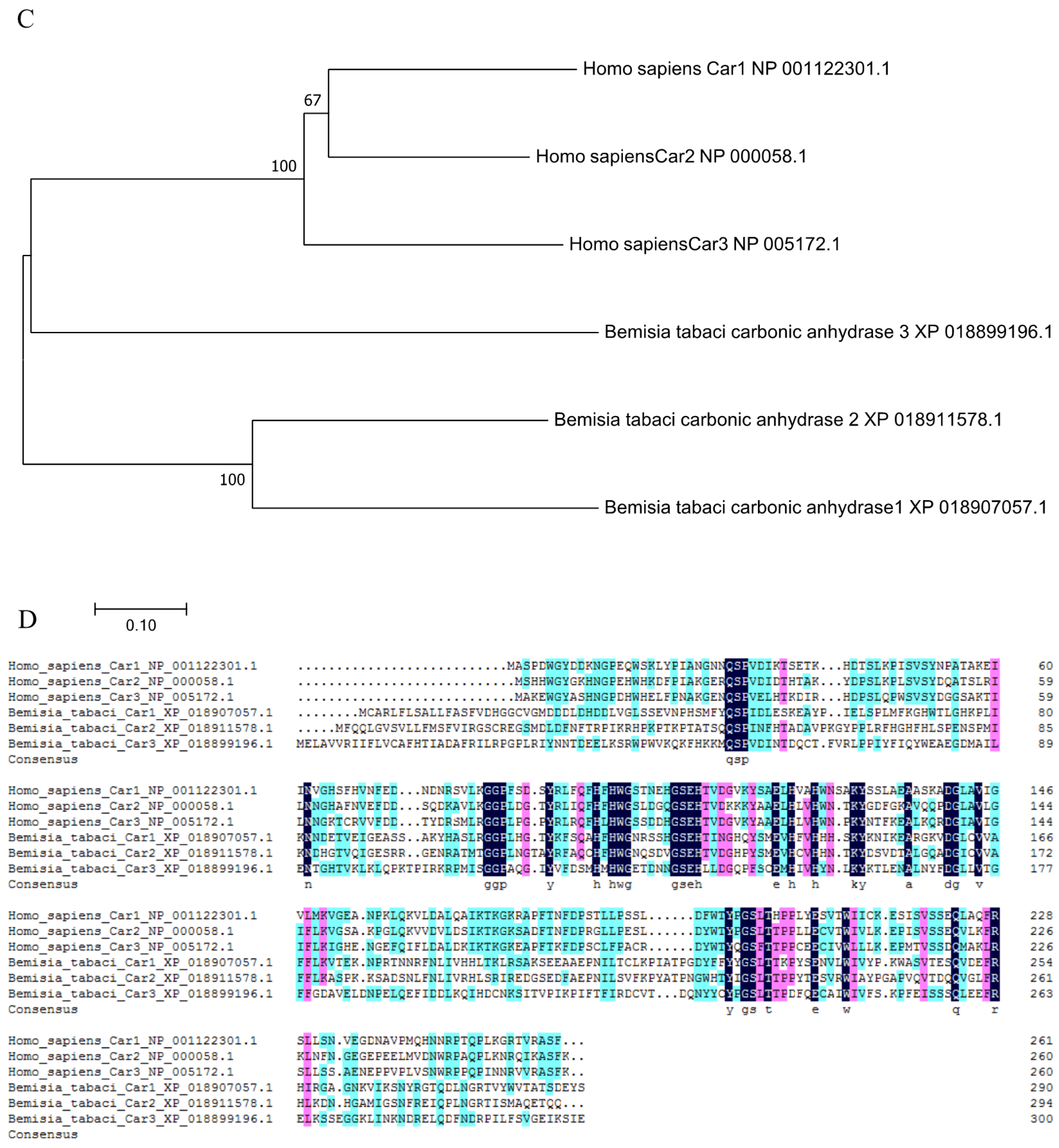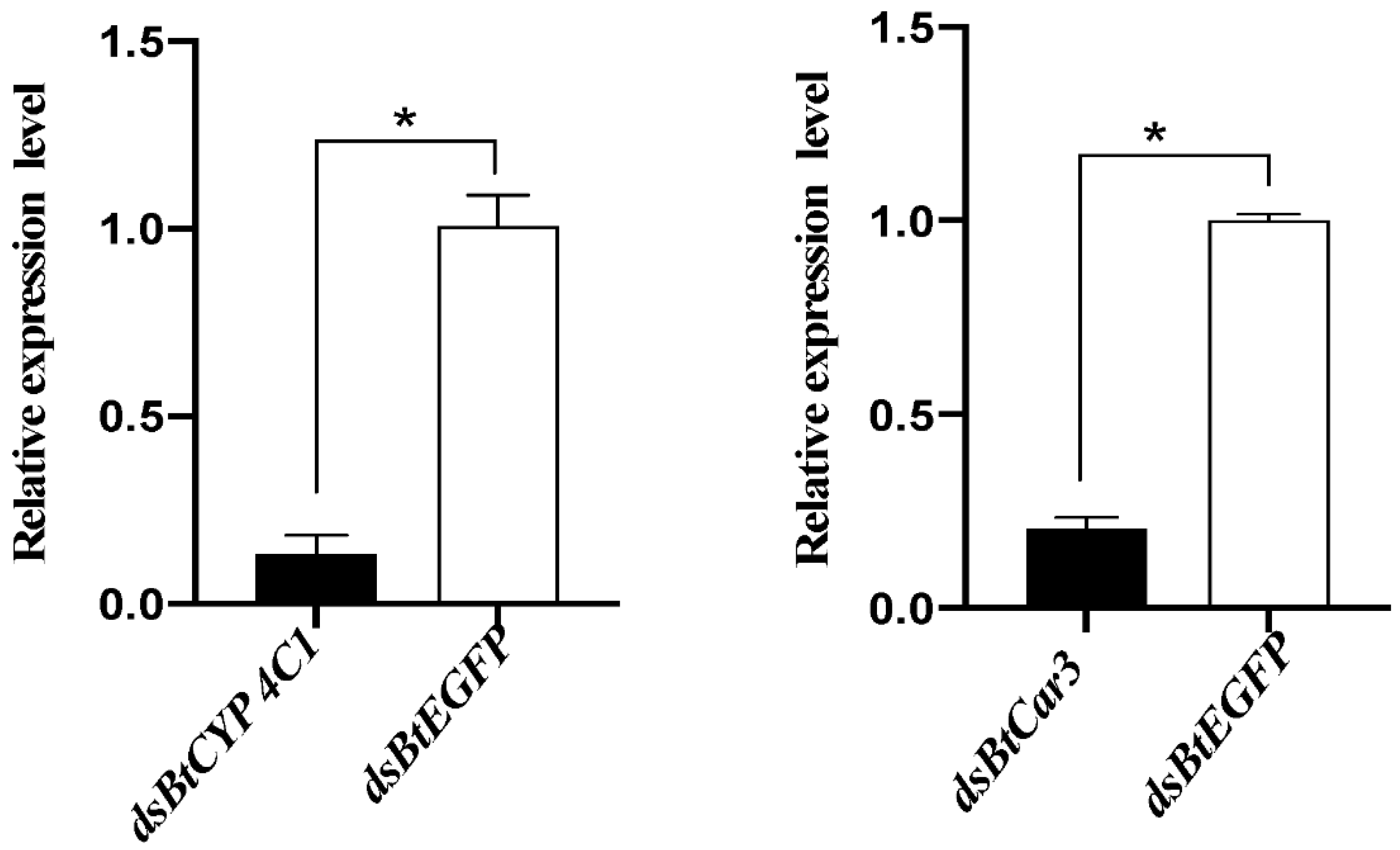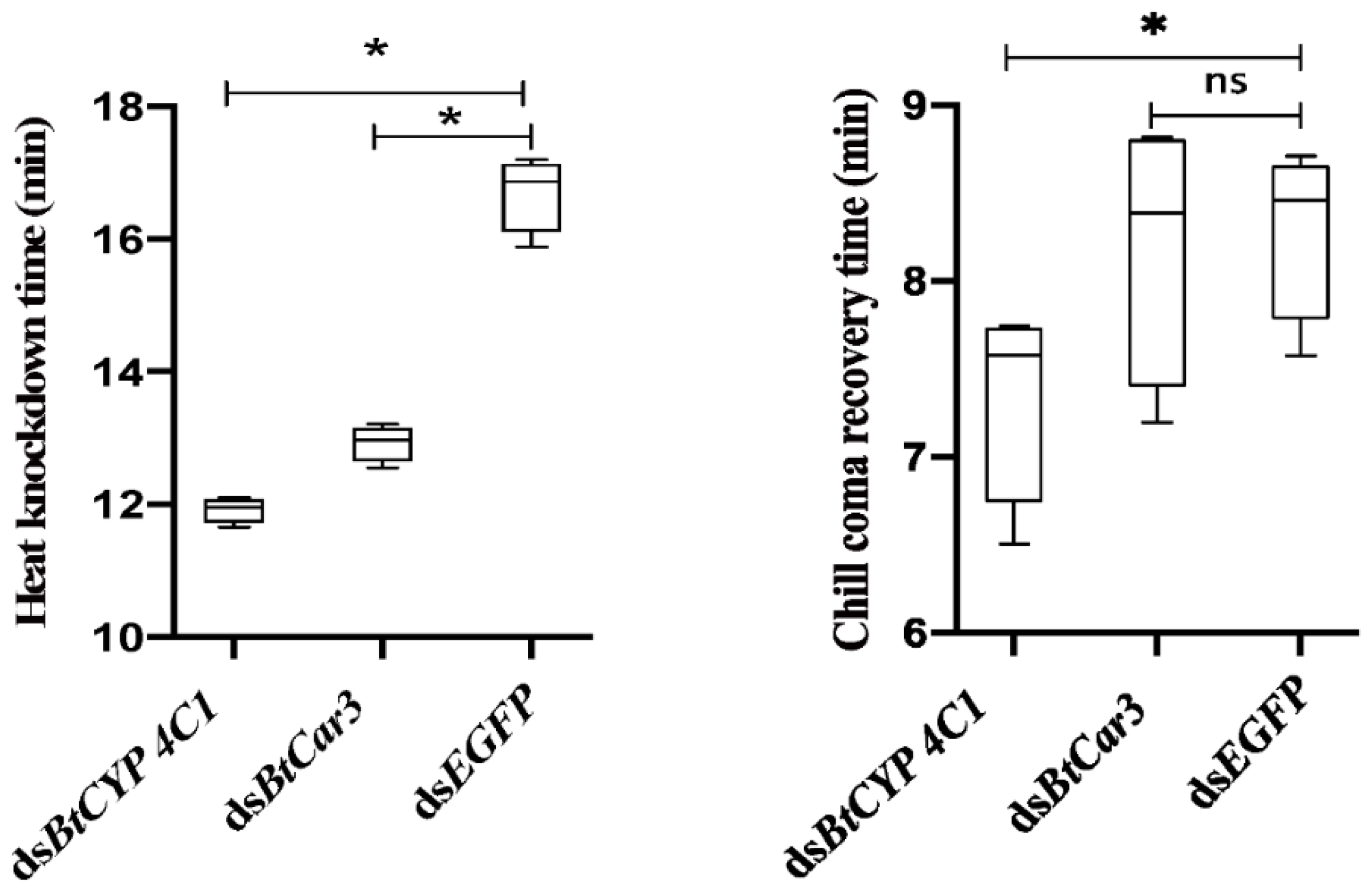The Role of Cytochrome P450 4C1 and Carbonic Anhydrase 3 in Response to Temperature Stress in Bemisia tabaci
Abstract
:Simple Summary
Abstract
1. Introduction
2. Materials and Methods
2.1. Experimental Insects
2.2. RNA Extraction and cDNA Synthesis
2.3. Sequence Analysis
2.4. Quantitative Real-Time PCR Analysis of Relative Expression Levels
2.5. RNA Interference and Phenotype Observation
2.6. Statistical Analysis
3. Results
3.1. Sequence and Characterization of BtCYP 4C1
3.2. Sequence and Characterization of BtCar3
3.3. mRNA Expression in B. tabaci after dsRNA Feeding
3.4. Effects of dsBtCYP 4C1-Feeding on Temperature Resistance
3.5. Effects of dsBtCar3-Feeding on Temperature Resistance
4. Discussion
Author Contributions
Funding
Institutional Review Board Statement
Data Availability Statement
Acknowledgments
Conflicts of Interest
References
- Ma, F.Z.; Lv, Z.C.; Wang, R.; Wan, F.H. Heritability and evolutionary potential in thermal tolerance traits in the invasive Mediterranean cryptic species of Bemisia tabaci (Hemiptera: Aleyrodidae). PLoS ONE 2014, 9, e103279. [Google Scholar] [CrossRef]
- Brown, J.K.; Frohlich, D.R.; Rosell, R.C. The sweet-potato or silverleaf whiteflies–biotypes of Bemisia-Tabaci or a species complex. Annu. Rev. Entomol. 1995, 40, 511–534. [Google Scholar] [CrossRef]
- Perring, T.M. The Bemisia tabaci species complex. Crop. Prot. 2001, 20, 725–737. [Google Scholar] [CrossRef]
- Kang, L.; Bing, C.; Wei, J.N.; Liu, T.X. Roles of thermal adaptation and chemical ecology in liriomyza distribution and control. Annu. Rev. Entomol. 2009, 54, 127–145. [Google Scholar] [CrossRef]
- Zhang, J.J.; Dong, Q.; Zhao, H.B.; Peng, H.J.; Zhang, W.Y.; Li, J.J.; Zhang, Y.Y.; Ren, B.Z. Overview of Invasive Distribution, Harm and Control of Hyphantria vulgaris in China. J. JiLin For. Sci. Technol. 2013, 3, 27–30. [Google Scholar]
- Luo, C.; Zhang, J.M.; Shi, B.C.; Zhang, F.; Zhang, Z.L. Preliminary report on the investigation of Bemisia tabaci (Gennadius) in Beijing. Beijing Agricultural. Sciences 2000, 1, 42–47. [Google Scholar]
- Shi, B.C.; Luo, C.; Zhang, J.M.; Gong, Y.J.; Lu, H.; Zhang, Z.L. Field efficacy test of 12 pesticides on Bemisia tabaci. Beijing Agricultural. Sciences 2000, 1, 48–54. [Google Scholar]
- Brown, J.K.; Czosnek, H. Whitefly transmission of plant viruses. Adv. Bot. Res. 2002, 36, 65–76. [Google Scholar]
- Byrne, D.N.; Bellows, T.S.J. Whitefly biology. Annu. Rev. Entomol. 2003, 36, 431–457. [Google Scholar] [CrossRef]
- De Barro, P.J.; Liu, S.S.; Boykin, L.M.; Dinsdale, A.B. Bemisia tabaci: A statement of species status. Annu. Rev. Entomol. 2011, 56, 1–19. [Google Scholar] [CrossRef] [PubMed]
- Dinsdale, A.; Cook, L.; Riginos, C.; Buckley, Y.M.; De Barro, P. Refined Global Analysis of Bemisia tabaci (Hemiptera: Sternorrhyncha: Aleyrodoidea: Aleyrodidae) Mitochondrial Cytochrome Oxidase 1 to Identify Species Level Genetic Boundaries. Ann. Entomol. Soc. Am. 2010, 103, 196–208. [Google Scholar] [CrossRef]
- Luo, C.; Zhang, Z.L. Occurrence and control of Bemisia tabaci. China Plant Prot. 2002, 22, 35–37. [Google Scholar]
- Lv, Z.C.; Wan, F.H. Differential gene expression in whitefly (Bemisia tabaci) B-biotype females and males under heat-shock condition. Comp. Biochem. Physiol. Part D Genom. Proteom. 2008, 3, 257–262. [Google Scholar]
- Mahadav, A.; Kontsedalov, S.; Czosnek, H.; Ghanim, M. Thermotolerance and gene expression following heat stress in the whitefly Bemisia tabaci B and Q biotypes. Insect Biochem. Mol. Biol. 2009, 39, 668–676. [Google Scholar] [CrossRef] [PubMed]
- Wang, B.; Hao, X.; Xu, J.; Wang, B.; Ma, W.; Liu, X.; Ma, L. Cytochrome CYP4C1. Metabolism mediates low-temperature resistance in pinewood nematode. FEBS Open Biol. 2020, 10, 1171–1179. [Google Scholar]
- Mvdra, B.; Lvr, A.; As, C.; Lk, C.; Sjcc, D.; Bc, E.; Pddop, B.; Ssk, A. Genome-wide. expression of low temperature response genes in Rosa hybrida L. Plant Physiol. Biochem. 2020, 146, 238–248. [Google Scholar]
- Kang, J.; Kim, J.; Choi, K.; Callaerts, P. Novel cytochrome CYP4C1, cyp6a17, is required for temperature preference behavior in drosophila. PLoS ONE 2011, 6, e29800. [Google Scholar] [CrossRef] [Green Version]
- Ye, W.; Zhang, C.; Xu, N.; Sun, Y.; Ma, L.; Shen, B.; Zhu, C. Carbonic. anhydrase ii confers resistance to deltamethrin in culex pipiens pallens. Arch. Insect Biochem. Physiol. 2017, 96, e21428. [Google Scholar] [CrossRef]
- Ercan, S.; Ahmet, G.; Selim, B.; Murat, S.; Claudiu, T.S.; Deniz, E. Carbonic anhydrase from Apis mellifera: Purification and inhibition by pesticides. J. Enzym. Inhib. Med. Chem. 2017, 32, 47–50. [Google Scholar]
- Dai, T.M.; Lv, Z.C.; Wang, Y.S.; Liu, W.X.; Hong, X.Y.; Wan, F.H. Molecular characterizations of DNA methyltransferase 3 and its roles in temperature tolerance in the whitefly, Bemisia tabaci Mediterranean. Insect Mol. Biol. 2018, 27, 123–132. [Google Scholar] [CrossRef]
- Ji, S.X.; Wang, X.D.; Shen, X.N.; Liang, L.; Liu, W.X.; Wan, F.H.; Lv, Z.C. Using RNA Interference to Reveal the Function of Chromatin Remodeling Factor ISWI in Temperature Tolerance in Bemisia tabaci Middle East-Asia Minor 1 Cryptic Species. Insects 2020, 11, 113. [Google Scholar] [CrossRef] [PubMed] [Green Version]
- Li, J.J.; Shi, Y.; Lin, G.L.; Yang, C.H.; Liu, T.X. Genome-wide identification of neuropeptides and their receptor genes in Bemisia tabaci and their transcript accumulation change in response to temperature stresses. Insect Sci. 2020, 28, 35–46. [Google Scholar] [CrossRef] [PubMed] [Green Version]
- Dai, T.M. The Characteristics of Temperature-Induced DNA Methylation and the Functional Identification of Dnmt1 Gene in Bemisia Tabaci Under Temperature Stress Condition; Chinese Academy of Agricultural Sciences: Beijing, China, 2015. [Google Scholar]
- Dai, T.M.; Lv, Z.C.; Liu, W.X.; Wan, F.H. Selection and validation of. reference genes for qRT-PCR analysis during biological invasions: The thermal adaptability of Bemisia tabaci MED. PLoS ONE 2017, 12, e0173821. [Google Scholar] [CrossRef]
- Livak, K.J.; Schmittgen, T.D. Analysis of relative gene expression data using real-time quantitative pcr. Methods 2002, 25, 402–408. [Google Scholar] [CrossRef]
- Tseng, M. A simple parafilm M-based method for bloodfeeding Aedes aegypti and Aedes albopictus (Diptera: Culicidae). J. Med. Entomol. 2003, 40, 588–589. [Google Scholar] [CrossRef] [PubMed]
- Zolfaghari, E.; Reza, B.; Harlan, H.; Vesa, P.T.; Martti, E.E.; Parkkila, S. Beta carbonic anhydrases: Novel targets for pesticides and anti-parasitic agents in agriculture and livestock husbandry. Parasites Vectors 2014, 7, 403. [Google Scholar] [CrossRef] [PubMed] [Green Version]





| Gene Name | Primer Name | Sequence Information (5′-3′) |
|---|---|---|
| BtCYP 4C1 | BtCYP 4C1-F | GGAGGAAGTGACAGACC |
| BtCYP 4C1-R | GTAAAAACGAATACGGG | |
| BtCar3 | BtCar3-F | GCGATGCGGTAGAGTTG |
| BtCar3-R | CGAAAGGTTTGCTGAAGA | |
| EF1-α | EF1-α-F | TAGCCTTGTGCCAATTTCCG |
| EF1-α-R | CCTTCAGCATTACCGTCC | |
| BtCYP 4C1 | T7 + BtCYP 4C1-F | TAATACGACTCACTATAGGGTGGATAGGCGAGGGTCT |
| T7 + BtCYP 4C1-R | TAATACGACTCACTATAGGGCGAATATTGCGTTGAGC | |
| BtCar3 | T7 + BtCar3-F | TAATACGACTCACTATAGGGGCCCCCTAAGGATTTATA |
| T7 + BtCar3-R | TAATACGACTCACTATAGGGCTTCCGTTGTTGTCTGTCT |
Publisher’s Note: MDPI stays neutral with regard to jurisdictional claims in published maps and institutional affiliations. |
© 2021 by the authors. Licensee MDPI, Basel, Switzerland. This article is an open access article distributed under the terms and conditions of the Creative Commons Attribution (CC BY) license (https://creativecommons.org/licenses/by/4.0/).
Share and Cite
Shen, X.; Liu, W.; Wan, F.; Lv, Z.; Guo, J. The Role of Cytochrome P450 4C1 and Carbonic Anhydrase 3 in Response to Temperature Stress in Bemisia tabaci. Insects 2021, 12, 1071. https://doi.org/10.3390/insects12121071
Shen X, Liu W, Wan F, Lv Z, Guo J. The Role of Cytochrome P450 4C1 and Carbonic Anhydrase 3 in Response to Temperature Stress in Bemisia tabaci. Insects. 2021; 12(12):1071. https://doi.org/10.3390/insects12121071
Chicago/Turabian StyleShen, Xiaona, Wanxue Liu, Fanghao Wan, Zhichuang Lv, and Jianying Guo. 2021. "The Role of Cytochrome P450 4C1 and Carbonic Anhydrase 3 in Response to Temperature Stress in Bemisia tabaci" Insects 12, no. 12: 1071. https://doi.org/10.3390/insects12121071





